Effects of phrixotoxins on the Kv4 family of potassium channels and implications for the role of Ito1 in cardiac electrogenesis
- PMID: 10051143
- PMCID: PMC1565788
- DOI: 10.1038/sj.bjp.0702283
Effects of phrixotoxins on the Kv4 family of potassium channels and implications for the role of Ito1 in cardiac electrogenesis
Abstract
1. In the present study, two new peptides, phrixotoxins PaTx1 and PaTx2 (29-31 amino acids), which potently block A-type potassium currents, have been purified from the venom of the tarantula Phrixotrichus auratus. 2. Phrixotoxins specifically block Kv4.3 and Kv4.2 currents that underlie I(to1), with an 5 < IC50 < 70 nM, by altering the gating properties of these channels. 3. Neither are the Shaker (Kv1), Shab (Kv2) and Shaw (Kv3) subfamilies of currents, nor HERG, KvLQT1/IsK, inhibited by phrixotoxins which appear specific of the Shal (Kv4) subfamily of currents and also block I(to1) in isolated murine cardiomyocytes. 4. In order to evaluate the physiological consequences of the Ito1 inhibition, mice were injected intravenously with PaTx1, which resulted in numerous transient cardiac adverse reactions including the occurrence of premature ventricular beats, ventricular tachycardia and different degrees of atrioventricular block. 5. The analysis of the mouse electrocardiogram showed a dose-dependent prolongation of the QT interval, chosen as a surrogate marker for their ventricular repolarization, from 249 +/- 11 to 265 +/- 8 ms (P < 0.05). 6. It was concluded that phrixotoxins, are new and specific blockers of Kv4.3 and Kv4.2 potassium currents, and hence of I(to1) that will enable further studies of Kv4.2 and Kv4.3 channel and/or I(to1) expression.
Figures


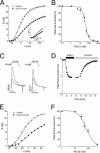
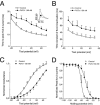
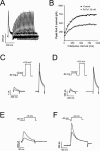
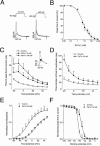
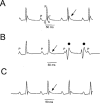
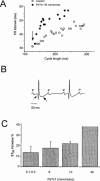
Similar articles
-
Modulation of Kv4.2 channels by a peptide isolated from the venom of the giant bird-eating tarantula Theraphosa leblondi.Toxicon. 2004 Jun 15;43(8):923-32. doi: 10.1016/j.toxicon.2003.12.012. Toxicon. 2004. PMID: 15208026
-
Expression of voltage-gated K+ channels in human atrium.Basic Res Cardiol. 2002 Nov;97(6):424-33. doi: 10.1007/s00395-002-0377-4. Basic Res Cardiol. 2002. PMID: 12395204
-
Heteropodatoxins: peptides isolated from spider venom that block Kv4.2 potassium channels.Mol Pharmacol. 1997 Mar;51(3):491-8. Mol Pharmacol. 1997. PMID: 9058605
-
Shal-type (Kv4.x) potassium channel pore blockers from scorpion venoms.Sheng Li Xue Bao. 2015 Jun 25;67(3):248-54. Sheng Li Xue Bao. 2015. PMID: 26109297 Review.
-
Functioning of K channels during sleep.Arch Insect Biochem Physiol. 2022 Jun;110(2):e21884. doi: 10.1002/arch.21884. Epub 2022 Mar 21. Arch Insect Biochem Physiol. 2022. PMID: 35313039 Free PMC article. Review.
Cited by
-
Effect of the I(to) activator NS5806 on cloned K(V)4 channels depends on the accessory protein KChIP2.Br J Pharmacol. 2010 Aug;160(8):2028-44. doi: 10.1111/j.1476-5381.2010.00859.x. Br J Pharmacol. 2010. PMID: 20649599 Free PMC article.
-
Peptide Inhibitors of Kv1.5: An Option for the Treatment of Atrial Fibrillation.Pharmaceuticals (Basel). 2021 Dec 14;14(12):1303. doi: 10.3390/ph14121303. Pharmaceuticals (Basel). 2021. PMID: 34959701 Free PMC article. Review.
-
Targeting voltage sensors in sodium channels with spider toxins.Trends Pharmacol Sci. 2010 Apr;31(4):175-82. doi: 10.1016/j.tips.2009.12.007. Epub 2010 Jan 25. Trends Pharmacol Sci. 2010. PMID: 20097434 Free PMC article. Review.
-
A-type K+ channels impede supralinear summation of clustered glutamatergic inputs in layer 3 neocortical pyramidal neurons.Neuropharmacology. 2018 Sep 15;140:86-99. doi: 10.1016/j.neuropharm.2018.07.005. Epub 2018 Jul 6. Neuropharmacology. 2018. PMID: 30009837 Free PMC article.
-
Calcium/calmodulin-dependent protein kinase II associates with the K+ channel isoform Kv4.3 in adult rat optic nerve.Front Neuroanat. 2022 Sep 8;16:958986. doi: 10.3389/fnana.2022.958986. eCollection 2022. Front Neuroanat. 2022. PMID: 36172564 Free PMC article.
References
-
- AIYAR J., WITHKA J.M., RIZZI J.P., SINGLETON D.H., ANDREWS G.C., LIN W., BOYD J., HANSON D.C., SIMON M., DETHLEFS B., LEE C., HALL J.E., GUTMAN G.A., CHANDY K.G. Topology of the pore-region of a K+ channel revealed by the NMR-derived structures of scorpions toxins. Neuron. 1995;15:1169–1181. - PubMed
-
- ATTALI B. Ion channels A new wave for heart rhythms. Nature. 1996;384:24–25. - PubMed
-
- BAGETTA G., NISTICO G., DOLLY J.O. Production of seizures and brain damage in rats by α-dendrotoxin, a selective K+ channel blocker. Neurosci. Lett. 1992;139:24–40. - PubMed
-
- BALDWIN T.J., TSAUR M.-L., LOPEZ G.A., JAN Y.N., JAN L.Y. Characterization of a mammalian cDNA for an inactivating voltage-sensitive K+ channel. Neuron. 1991;7:471–483. - PubMed
-
- BARHANIN J., LESAGE F., GUILLEMARE E., FINK M., LAZDUNSKI M., ROMEY G. KvLQT1 and Isk (minK) proteins associate to form the IKs cardiac potassium current. Nature. 1996;384:78–80. - PubMed
Publication types
MeSH terms
Substances
LinkOut - more resources
Full Text Sources
Other Literature Sources
Molecular Biology Databases

